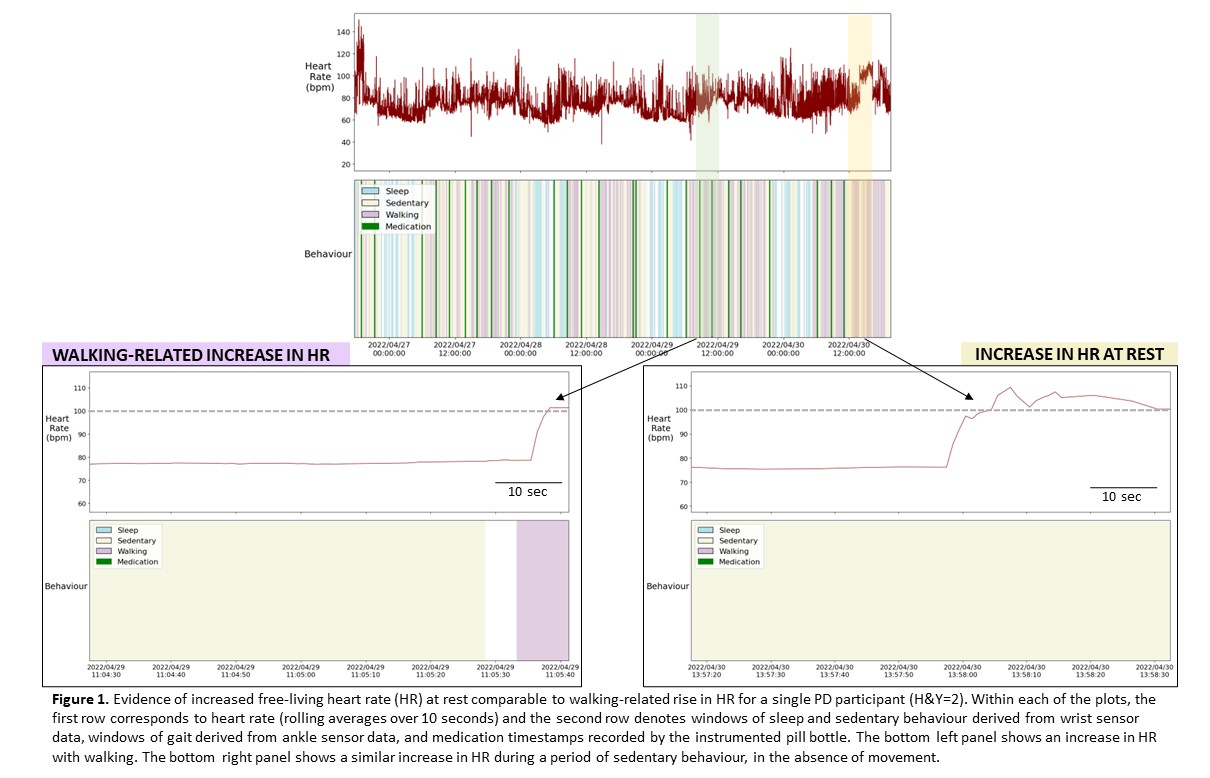Category: Technology
Objective: To examine context-specific fluctuations in free-living heart rate (HR) across a week-long multi-sensor wear period in people with Parkinson’s disease (PD).
Background: Non-motor symptoms, including autonomic dysfunction and neuropsychiatric fluctuations, are prevalent in PD and can be severely disabling; however, their occurrence in daily life are not well characterized. Continuous collection of high-fidelity HR data synchronized with data from multiple body worn inertial measurement units (IMUs) enables changes in HR to be identified and contextualized by coincident behavioural information. This includes characterization of instances of elevated HR during periods of free-living rest as a potential window into non-motor drivers of HR change.
Method: The Health in Aging, Neurodegenerative Diseases and Dementias in Ontario (HANDDS-ONT) PD Impact Study included ten participants with PD (69±6 years, 50% female, MoCA=26±2, H&Y=2.5±0.5) who were currently taking levodopa. Participants arrived at the clinic in an OFF state and were instrumented with 5 wearable sensors, including 4 limb IMUs and 1 chest electrocardiography (ECG) monitor. They wore the sensors during an in-clinic levodopa challenge test and then continuously for 7-10 days of remote monitoring. HR was derived from ECG data. Activity intensity, sleep, and walking were detected and quantified using IMU data and an instrumented pill bottle collected medication timestamps.
Results: Participants averaged 8722±5367 steps/day, 5.2±1.1 hours of sleep/night, and wore the ECG monitor for 98±2% of the remote monitoring period. Initial results showed increases in HR as much as 20 bpm during sedentary behaviour (i.e., in the absence of movement), which were comparable to walking-induced HR changes [figure1]. Ongoing analyses will characterize free-living HR change across all participants and explore associations with clinical measures of non-motor symptom severity and autonomic dysfunction (e.g., MDS-UPDRS, SCOPA-AUT, Neuropsychiatric Fluctuations Scale), as well as medication-taking.
Conclusion: Measuring free-living HR in the context of well-defined behaviours may serve as a potential approach for assessing autonomic dysfunction and related neuropsychiatric fluctuations in PD and enable improvements in treatment and management.
figure1
To cite this abstract in AMA style:
FE. Godkin, K. van Ooteghem, K. Ehgoetz Martens, K. Weber, B. Cornish, K. Beyer, D. Olszewska, C. Fearon, A. Lang, R. Swartz, M. Masellis, B. Tan, J. Tung, A. Roberts, W. Mcilroy. Examining and contextualizing free-living heart rate using multiple wearable sensors: a potential approach for assessing autonomic dysfunction in Parkinson’s disease? [abstract]. Mov Disord. 2024; 39 (suppl 1). https://www.mdsabstracts.org/abstract/examining-and-contextualizing-free-living-heart-rate-using-multiple-wearable-sensors-a-potential-approach-for-assessing-autonomic-dysfunction-in-parkinsons-disease/. Accessed November 7, 2025.« Back to 2024 International Congress
MDS Abstracts - https://www.mdsabstracts.org/abstract/examining-and-contextualizing-free-living-heart-rate-using-multiple-wearable-sensors-a-potential-approach-for-assessing-autonomic-dysfunction-in-parkinsons-disease/

